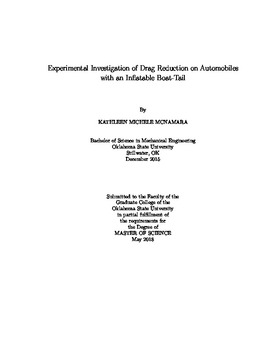| dc.description.abstract | There is a growing demand for higher efficiency and more environmentally friendly vehicles, including better fuel economy, reduction in wind noise level, and greater vehicle performance and dynamic stability. These factors vary with aerodynamic performance. Overall, aerodynamic drag contributes to as much as 60% of a vehicles fuel consumption, motivating vehicle manufacturers to investigate new drag reduction applications. When streamlining a vehicle for aerodynamic performance, one method is by boat-tailing, or rear end tapering. This study includes an investigation of the overall potential of a lightweight yet rigid, inflatable drag reduction device, applied to a motor vehicle. Based on original concepts proposed by Toyota Research Institute North American (TRINA), combined with past research of inflatable technology, an inflatable drag reduction device is designed, manufactured, and tested. Peel strength of adhesive bonds testing provides detailed results of proper heat-sealable fabric utilization, and preferred materials are selected for inflatable models. Through multiple concept considerations and varying design stages ergonomic boat-tail designs evolve, as does construction, and manufacturing details are included. The inflatable boat-tail as a drag reduction device is examined through wind tunnel testing at Reynolds numbers O(10^5) by 2D wake survey and conservation of momentum theory, and multiple system designs are compared. Results show 10-80% decreased drag coefficients as a function of varying boat-tail construction compared to a baseline model. Wake survey is also performed at multiple heights along boat-tail sections, and 3D effects are investigated. Further investigations include wake survey velocity profiles as a function of angle of attack. Standard deviation and velocity fluctuations are compared for individual systems, and results are discussed. | |
